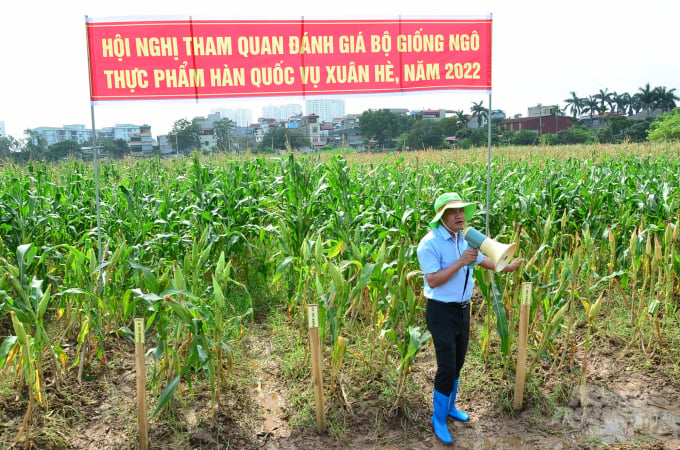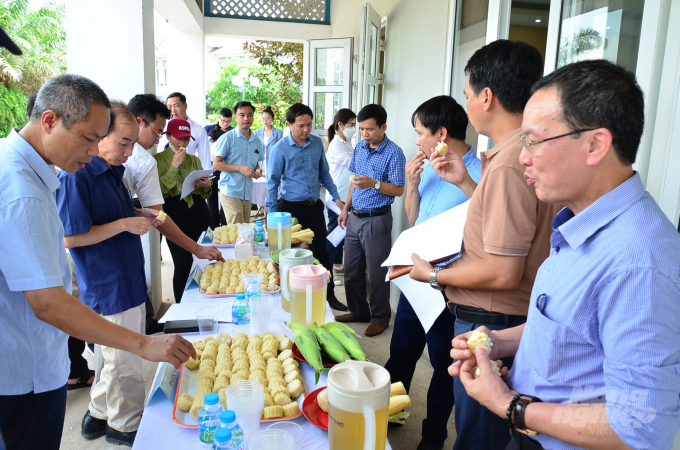May 30, 2025 | 02:38 GMT +7
May 30, 2025 | 02:38 GMT +7
Hotline: 0913.378.918
May 30, 2025 | 02:38 GMT +7
Hotline: 0913.378.918
The glutinous corn varieties considered to be the most delicious, mass-produced in Vietnam such as HN88, HN68, have exhibited better growth capacity compared to that of Korean varieties. Dr. Vuong Huy Minh, Deputy Director of the National Maize Research Insitute, explained that it is possible that the domestic maize variety is better adjusted compared to the foreign variety, but both varieties seem to produce good seeds.
“According to glutinous maize researchers, varieties with poor tolerance, smooth, soft leaves and susceptible to pests and diseases are often high quality because they are attractive to pests. Maize producers wants glutinous maize harvesting season to last 1 week, with small core, spicy deep seeds. On the other hand, consumers want that white glutinous maize to have white beard, not stuck to the seed row. There are two varieties we observed today, HN88 of Vietnam and Park Sa of Korea, which exhibit these characteristics", said Dr. Minh.

Experimental fields of Vietnamese and Korean glutinous maize varieties. Photo: Duong Dinh Tuong.
After visiting the fields, the delegates were excited to taste boiled corn products. The criteria to evaluate a good variety of glutinous maize include color, grain, aroma, bold taste, sweetness, softness and overall palatability. The visitors were told to drink a little water to clean their pallete after tasting every maize variety and get an accurate taste.
Due to the long and short growing time, it is unfar to compare the young maize with the old autumn maize. But Dr. Vuong Huy Minh as well as many other Vietnamese people are impressed with the Korean Park Sa variety because it can match the quality of the current best Vietnamese variety - HN88, soft, fragrant, sweet, bold.
However, surprisingly, Mr. Hyun Jong Nae, Director of Vietnam Kopia (Korea Program for International cooperation in Agricultural technology) claimed that this variety is the least popular in his country, with the most popular and delicious one being Ilmichal.
According to Mr. Hyun Jong Nae, the taste depends on the age and personal preferences. Koreans also have the habit of eating boiled glutinous maize like Vietnamese people, but they prefer the maize to be sticky when chewed like Ilmichal without being too soft. The two varieties of Vietnamese glutinous maize are also excellent, but they are not sticky so as to stimulate the feeling of chewing like the Korean variety.
"This is a small project by Kopia with the aim of bringing the most popular Korean maize varieties to Vietnam to see if they can adapt, as well as gauge consumers' reaction, to see if there is a potential for development. Five varieties were put to trial planting in Vietnam, four of which are suitable for four climate zones of Korea, and Vietnam also has many different climate regions.

Taste test of boiled glutinous maize of Korean and Vietnamese varieties. Photo: Duong Dinh Tuong.
Vietnam currently has 750,000 hectares of maize, including 60,000 hectares of glutinous maize.4,000 tons of seed are used annually, including local varieties and commercial varieties produced by companies. Dr. Do Van Ngoc (Center for Technology Transfer and Agricultural Extension - Vietnam Academy of Agricultural Sciences), Project Manager of the Demonstration trial of quality food maize varieties (glutinous corn, sugar corn) reported that the testing period lasts from November 2021 to November 2022. For the spring-summer crop of 2022, the unit tested 5 Korean glutinous maize varieties including Ilmichal, Chal Ok 4 Ho, Mibeak, Park Sa, Dea Hak with 2 Vietnamese control varieties, HN68 and HN88.
There was a clear distinction in growth and development between the 7 varieties tested, 2 glutinous maize varieties Mi beak and Dea Hark had high germination rate but exhibited stunted plants and poor growth. They have a very short window from sowing to blooming, only 37 - 38 days for Mibeak and 40 - 41 days for Dea Hark. Due to their temperate origin, these varieties react strongly to temperature, time and light intensity in tropical climate, and the yield is low.
Glutinous maize varieties of Park Sa, Ilmichal, Chal Ok 4Ho and 2 control varieties of HN68 and HN88 have all grown well, with high uniformity, and free of pests and diseases. However, due to the hurricane on May 2, 2022, they all uprooted, except for the Dea Hark and Mibeak varieties, which did not fall over due to stunted plants. This is also the factor affecting productivity and quality.

Examination of the seed quality. Photo: Duong Dinh Tuong.
In reality, there are 2 promising Korean glutinous maize varieties, Park Sa and Ilmichal, with shorter average growth time, average plant morphology, and relatively high yield at14 tons per hectare and 12.1 tons per hectare.
Regarding quality, Korean glutinous maize varieties all had higher Brix index (sweetness) than the control variety, with the highest of Mibeak variety at 14.6 0Bx and DeaHark variety at 13.2 0Bx, while the HN88 control variety only reached 11.2 0Bx. The Korean glutinous maize varieties all have lower amynopectin content or equivalent compared to the HN88 control variety, or specifically, higher plasticity.
Through the monitoring and evaluation of agro-biological characteristics, growth time, yield as well as quality indicators, the preliminary testing unit commented: Two Korean glutinous maize varieties of Park Sa and Ilmichal have high yield, shorter average growth time, mild pest and disease infection, delicious when eaten fresh (soft, sweet and aromatic), suitable for consumers' tastes. However, it is necessary to repeat the experiment for the next crop to have more accurate conclusions about the adaptability, yield as well as quality indicators for Korean glutinous maze varieties under Vietnamese production conditions.
Translated by Nguyen Hai Long
/2025/05/25/4127-3-073637_820.jpg)
(VAN) Thanks to the promotion from an FAO-implemented project, vegetable production in greenhouses in Moc Chau has seen strong development, from 1.5 hectares in 2021 to nearly 50 hectares in 2024.

(VAN) FAO has recently supported USD 140,000 to implement the project 'Risk mitigation human-animal interface risks through disease control initiatives in pig farming.'

(VAN) The People's Committee of Tra Vinh province has approved an adjustment to the investment policy for the Green Hydrogen Plant project, increasing its area to approximately 52.76 hectares.
![Reducing emissions from rice fields: [2] Farmers’ commitment to the soil](https://t.ex-cdn.com/nongnghiepmoitruong.vn/608w/files/news/2025/05/05/dsc08881jpg-nongnghiep-140632.jpg)
(VAN) Clean rice cultivation model in Thuong Tan commune, Bac Tan Uyen district, is assisting local residents in achieving sustainable agriculture by substantially reducing costs, increasing productivity, and protecting the environment.

(VAN) At the conference to disseminate Resolution No. 68, AgriS introduced its digital agricultural ecosystem and reaffirmed its commitment to accompanying the Government in promoting private sector development and sustainable agriculture.

(VAN) 'Blue Ocean - Blue Foods' initiative is designed to restore marine ecosystems and establish sustainable livelihoods for local communities by cultivating a minimum of 1,000 hectares of cottonii seaweed in the first three years.
/2025/05/21/4642-3-112707_603.jpg)
(VAN) The V-SCOPE project has made direct contributions to three out of six pillars of the Comprehensive Strategic Partnership between Vietnam and Australia.